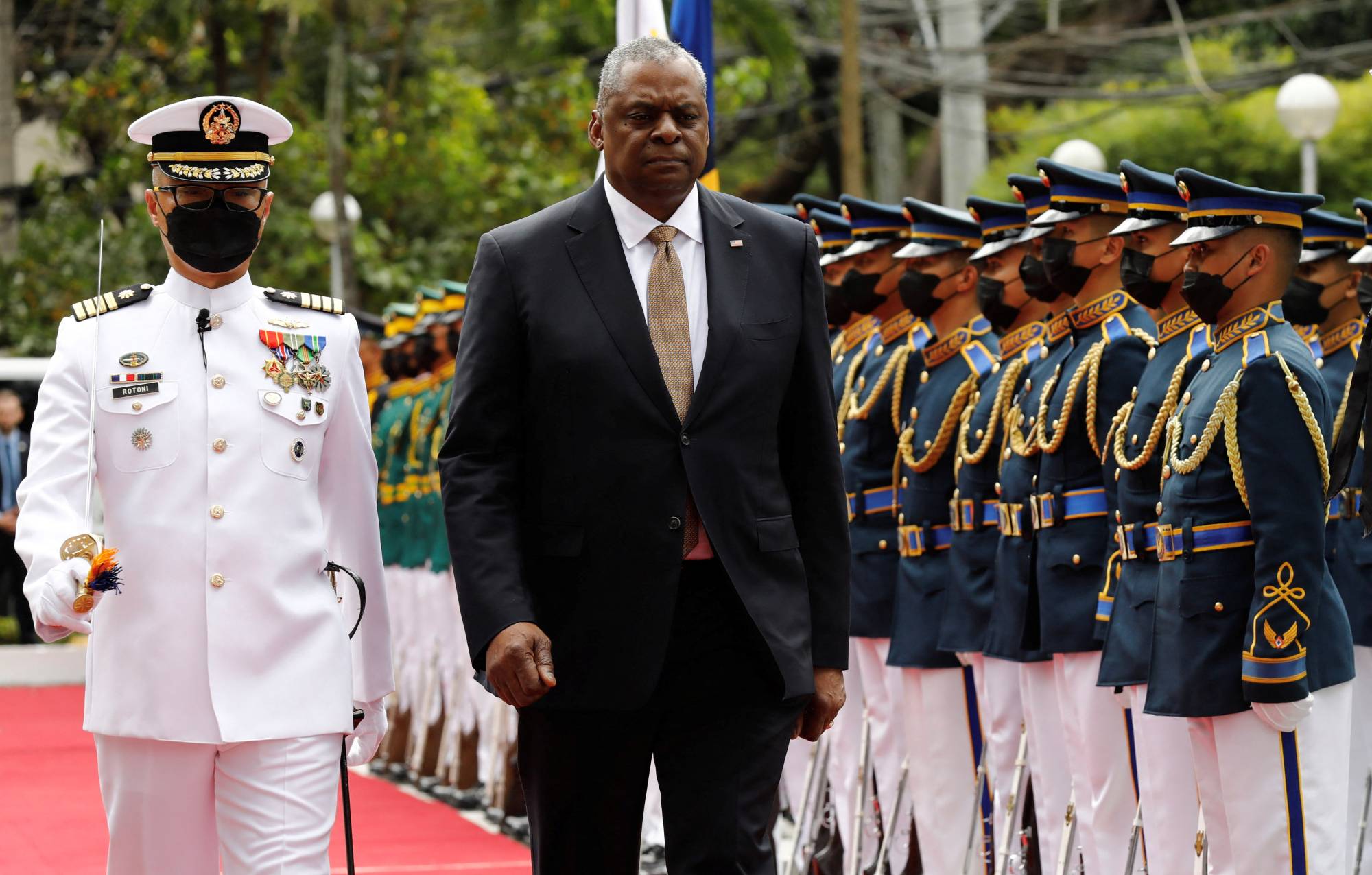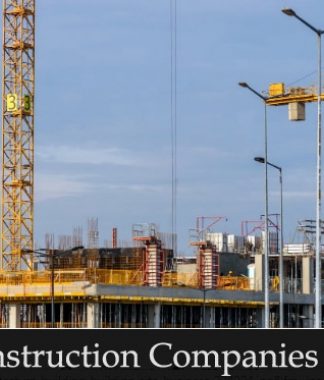ASIA PACIFIC | ANALYSIS
Philippines agrees to larger U.S. military presence as allies seek to deter China
U.S. Defense Secretary Lloyd Austin visits the Department of National Defense at Camp Aguinaldo military camp in Quezon City, Metro Manila, Philippines, on Thursday. | POOL / VIA REUTERS
U.S. Defense Secretary Lloyd Austin visits the Department of National Defense at Camp Aguinaldo military camp in Quezon City, Metro Manila, Philippines, on Thursday. | POOL / VIA REUTERS
BY GABRIEL DOMINGUEZ
STAFF WRITER
Feb 2, 2023
SHARE
With Manila emerging as a critical element in the Pentagon’s plans to counter China, the United States and the Philippines have reached a deal that will see Washington substantially increase its military footprint in the Southeast Asian country.
Announced Thursday by U.S. Defense Secretary Lloyd Austin and his Philippine counterpart, Carlito Galvez Jr., in Manila, the pact will grant U.S. forces access to four more military sites in the country — in addition to a previously agreed five — providing Washington with a strategic footing on the southeastern edge of the disputed South China Sea.
The Pentagon did not identify the new sites, saying only that they will be in “strategic areas” of the country. Media reports, however, put most of the new facilities on the main island of Luzon, the closest Philippine landmass to Taiwan, where U.S. forces already have access to two military facilities.
Another site would reportedly be located on the western island of Palawan, facing the contested Spratly Islands, as the longtime allies seek to deter Chinese aggression in the South China Sea and against Taiwan.
“We remain committed to strengthening our mutual capacities to resist armed attack,” Austin said at a news briefing, adding that this is especially important “as the People’s Republic of China continues to advance its illegitimate claims in the South China Sea.”
Referring to relations with the Philippines, Washington’s oldest treaty ally in Asia, Austin said the two countries “are more than just allies, we are family.”
The deal is linked to efforts to expand and expedite the implementation of the 2014 Enhanced Defense Cooperation Agreement (EDCA), which had stalled for years under the previous Philippine government of President Rodrigo Duterte.
The guided-missile destroyer USS Benfold conducts operations in the South China Sea in July. | U.S. NAVY / VIA REUTERS
The guided-missile destroyer USS Benfold conducts operations in the South China Sea in July. | U.S. NAVY / VIA REUTERS
“The EDCA is a key pillar of the U.S.-Philippine alliance, which supports combined training, exercises, and interoperability between our forces,” the Pentagon said in a statement, adding that the agreed expansion “will accelerate modernization of our combined military capabilities.” It also stated that the new locations will allow the U.S. to provide more rapid support for humanitarian and climate-related disasters in the Philippines and respond to “other shared challenges.”
Signed in 2014 under the administration of then-U.S. President Barack Obama, the EDCA — which builds upon the two countries’ 1951 Mutual Defense Treaty — enables Washington to rotate troops into the Philippines for extended stays, build facilities and pre-position both assets and supplies at designated Philippine military facilities.
The pact, however, does not allow for permanent basing.
Although the deal faded from attention during the Duterte administration, the U.S. revealed last November that it had already allocated over $82 million toward implementing the agreement at the existing locations, adding that more funds were “on the way.”
Washington had proposed the additional locations to help build a “more credible” mutual defense posture. “What we’re doing with Philippines is working with them … so that together as an alliance, we can help ensure their future, and so they have the capability to defend their own sovereignty and prevent the kind of coercion that they’re facing on a day-to-day basis,” a U.S. defense official said earlier this week.
The move, which is expected to anger Beijing, is bound to have geopolitical implications for the region, particularly given Manila’s ongoing territorial and maritime disputes with Beijing.
So why did Manila agree?
Unlike Duterte, who sought to pivot away from the United States and move toward China, President Ferdinand Marcos Jr. wants to mend ties with Washington while taking a firm stance against China’s territorial claims in the South China Sea.
Manila continues to protest what it views as the repeated harassment of Philippine fishermen by China’s coast guard and the country’s “maritime militia” — vessels that are on the surface engaged in commercial fishing but also operate alongside law enforcement and the navy. The Philippines has also expressed concerns about the Chinese exploitation of fisheries and energy resources in what it regards as Philippine waters.
Against this backdrop, Herman Joseph Kraft, a political science professor at the University of the Philippines Diliman, explained that, for Manila, the main goal of the agreement is to enhance Washington’s capacity to assist the Philippines in defense-related emergencies, particularly with regard to its territorial claims in the South China Sea.
Austin visits the Armed Forces of the Philippines’ Western Mindanao Command in Zamboanga city, Philippines, on Wednesday. | AFP WESTERN MINDANAO COMMAND / VIA REUTERS
Austin visits the Armed Forces of the Philippines’ Western Mindanao Command in Zamboanga city, Philippines, on Wednesday. | AFP WESTERN MINDANAO COMMAND / VIA REUTERS
In turn, the move provides Washington with additional capacity and options to respond to other potential military contingencies in the region, particularly over Taiwan, which a four-star U.S. Air Force general warned could happen as early as 2025.
“The fact is that the United States cannot possibly follow through on its commitment to defend Filipinos in the South China Sea if American forces don’t have access to facilities in the Philippines,” said Gregory Poling, director of the Southeast Asia Program at the Center for Strategic and International Studies think thank.
Poling also pointed to additional benefits under the EDCA, saying that the deal brings the Philippine alliance into closer coordination with other U.S. alliances in the region, all of which have been modernizing and integrating with a renewed focus on deterring Chinese aggression and responding to gray zone challenges.
Moreover, the EDCA will help boost the country’s military modernization as Washington will build infrastructure at these bases for use by both sides and help train Philippine forces, he added.
Although the deal is mainly the result of a long-standing request from the United States, Beijing might interpret this as the Marcos administration sending out a message of deterrence.
“Neither Philippine nor American officials want a fight with China. But the only way to deter violence while still defending shared U.S.-Philippine interests is by strengthening their alliance and making it clear to Beijing that the Philippines does not stand alone,” said Poling.
As for Washington, access to more Philippine facilities, along with existing U.S. bases in Japan, would be key in a potential Taiwan crisis, especially since Beijing’s militarization of the South China Sea could effectively deny U.S. surface ships and aircraft access to that body of water in a crisis.
As the U.S. continues strengthening its network of regional security alliances, experts say the EDCA expansion sends a message about how seriously Washington is taking its strategic pivot to Asia, with professor Kraft indicating that the latest agreement signals to friends and allies that Washington is “committed to playing a more active role in the region.”
KEYWORDS
CHINA, U.S., PHILIPPINES, U.S. MILITARY, SOUTH CHINA SEA






























